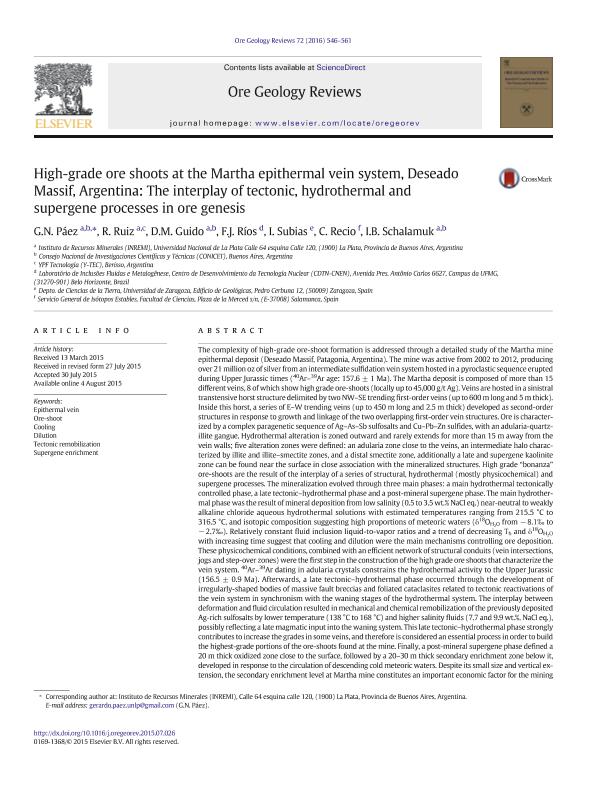Artículo
High-grade ore shoots at the Martha epithermal vein system, Deseado Massif, Argentina: The interplay of tectonic, hydrothermal and supergene processes in ore genesis
Paez, Gerardo Nestor ; Ruiz, R.; Guido, Diego Martin
; Ruiz, R.; Guido, Diego Martin ; Ríos, Francisco Javier; Subías Pérez, Ignacio; Recio, C.; Schalamuk, Bernardo Isidoro
; Ríos, Francisco Javier; Subías Pérez, Ignacio; Recio, C.; Schalamuk, Bernardo Isidoro
 ; Ruiz, R.; Guido, Diego Martin
; Ruiz, R.; Guido, Diego Martin ; Ríos, Francisco Javier; Subías Pérez, Ignacio; Recio, C.; Schalamuk, Bernardo Isidoro
; Ríos, Francisco Javier; Subías Pérez, Ignacio; Recio, C.; Schalamuk, Bernardo Isidoro
Fecha de publicación:
01/2016
Editorial:
Elsevier Science
Revista:
Ore Geology Reviews
ISSN:
0169-1368
Idioma:
Inglés
Tipo de recurso:
Artículo publicado
Clasificación temática:
Resumen
The complexity of high-grade ore-shoot formation is addressed through a detailed study of the Martha mine epithermal deposit (Deseado Massif, Patagonia, Argentina). The mine was active from 2002 to 2012, producing over 21millionoz of silver from an intermediate sulfidation vein system hosted in a pyroclastic sequence erupted during Upper Jurassic times (40Ar-39Ar age: 157.6±1Ma). The Martha deposit is composed of more than 15 different veins, 8 of which show high grade ore-shoots (locally up to 45,000g/t Ag). Veins are hosted in a sinistral transtensive horst structure delimited by two NW-SE trending first-order veins (up to 600m long and 5m thick). Inside this horst, a series of E-W trending veins (up to 450m long and 2.5m thick) developed as second-order structures in response to growth and linkage of the two overlapping first-order vein structures. Ore is characterized by a complex paragenetic sequence of Ag-As-Sb sulfosalts and Cu-Pb-Zn sulfides, with an adularia-quartz-illite gangue. Hydrothermal alteration is zoned outward and rarely extends for more than 15m away from the vein walls; five alteration zones were defined: an adularia zone close to the veins, an intermediate halo characterized by illite and illite-smectite zones, and a distal smectite zone, additionally a late and supergene kaolinite zone can be found near the surface in close association with the mineralized structures. High grade "bonanza" ore-shoots are the result of the interplay of a series of structural, hydrothermal (mostly physicochemical) and supergene processes. The mineralization evolved through three main phases: a main hydrothermal tectonically controlled phase, a late tectonic-hydrothermal phase and a post-mineral supergene phase. The main hydrothermal phase was the result of mineral deposition from low salinity (0.5 to 3.5wt.% NaCl eq.) near-neutral to weakly alkaline chloride aqueous hydrothermal solutions with estimated temperatures ranging from 215.5°C to 316.5°C, and isotopic composition suggesting high proportions of meteoric waters (δ18OH2O from -8.1‰ to -2.7‰). Relatively constant fluid inclusion liquid-to-vapor ratios and a trend of decreasing Th and δ18OH2O with increasing time suggest that cooling and dilution were the main mechanisms controlling ore deposition. These physicochemical conditions, combined with an efficient network of structural conduits (vein intersections, jogs and step-over zones) were the first step in the construction of the high grade ore shoots that characterize the vein system. 40Ar-39Ar dating in adularia crystals constrains the hydrothermal activity to the Upper Jurassic (156.5±0.9Ma). Afterwards, a late tectonic-hydrothermal phase occurred through the development of irregularly-shaped bodies of massive fault breccias and foliated cataclasites related to tectonic reactivations of the vein system in synchronism with the waning stages of the hydrothermal system. The interplay between deformation and fluid circulation resulted in mechanical and chemical remobilization of the previously deposited Ag-rich sulfosalts by lower temperature (138°C to 168°C) and higher salinity fluids (7.7 and 9.9wt.%. NaCl eq.), possibly reflecting a late magmatic input into the waning system. This late tectonic-hydrothermal phase strongly contributes to increase the grades in some veins, and therefore is considered an essential process in order to build the highest-grade portions of the ore-shoots found at the mine. Finally, a post-mineral supergene phase defined a 20m thick oxidized zone close to the surface, followed by a 20-30m thick secondary enrichment zone below it, developed in response to the circulation of descending cold meteoric waters. Despite its small size and vertical extension, the secondary enrichment level at Martha mine constitutes an important economic factor for the mining operations as it helped to increase the silver grades in the shallower portion of the vein system. The Martha mine vein system constitutes an excellent example of how the interplay of hydrothermal processes controlling mineral deposition, structural factors building up an efficient plumbing system, tectonic ore-remobilization, and late supergene secondary enrichment processes, are combined in order to build "bonanza"-grade ore shoots in the epithermal environment.
Archivos asociados
Licencia
Identificadores
Colecciones
Articulos(CCT - LA PLATA)
Articulos de CTRO.CIENTIFICO TECNOL.CONICET - LA PLATA
Articulos de CTRO.CIENTIFICO TECNOL.CONICET - LA PLATA
Citación
Paez, Gerardo Nestor; Ruiz, R.; Guido, Diego Martin; Ríos, Francisco Javier; Subías Pérez, Ignacio; et al.; High-grade ore shoots at the Martha epithermal vein system, Deseado Massif, Argentina: The interplay of tectonic, hydrothermal and supergene processes in ore genesis; Elsevier Science; Ore Geology Reviews; 72; P1; 1-2016; 546-561
Compartir
Altmétricas



